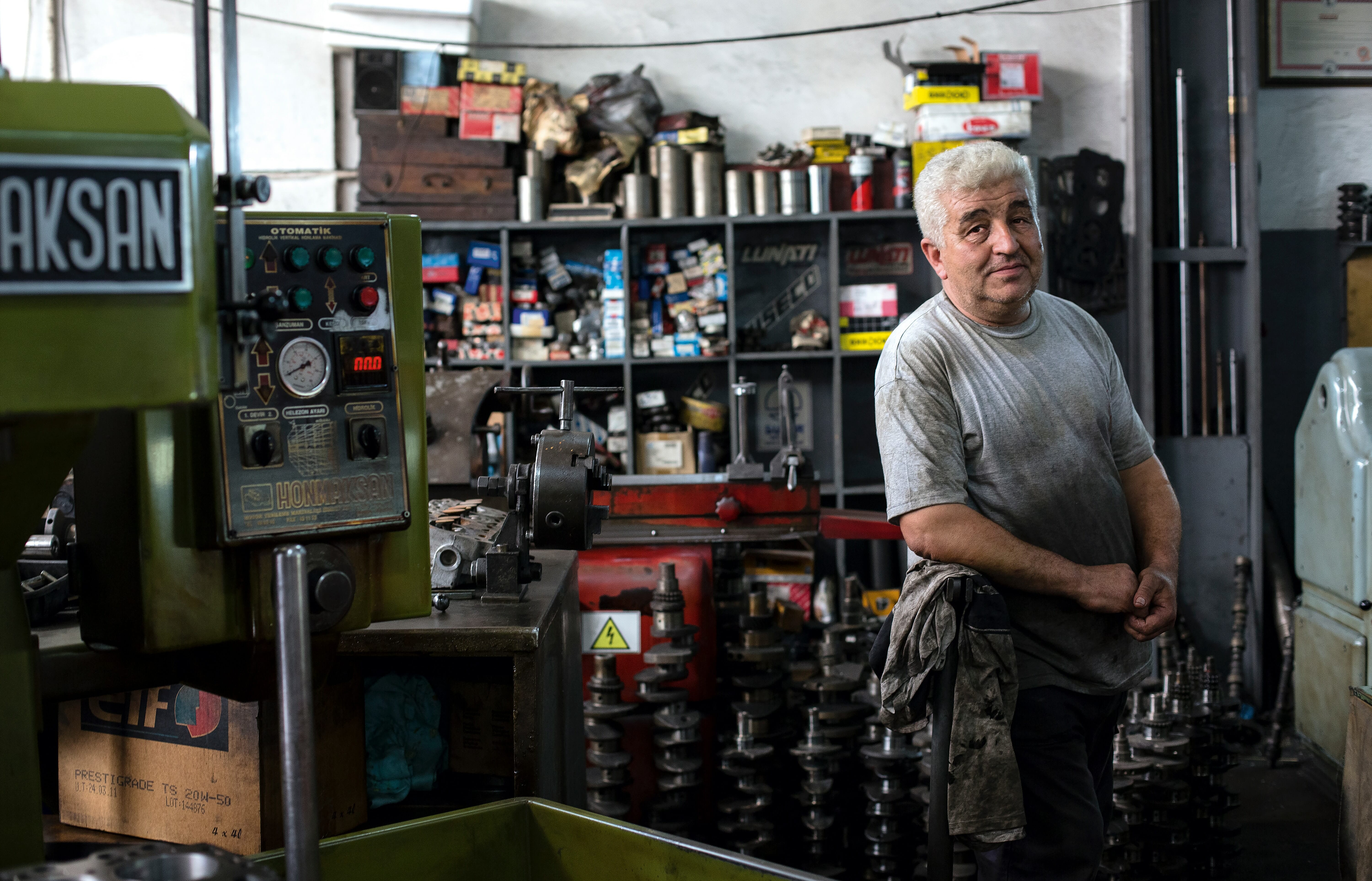New challenges as an older worker

I work at a car wash in the winter, unbenownst to my son. I am 73 years old. My son is a proud man and might not like to see his father this way. Others in the community might say, ‘the son is earning so much from his business, but their father works at a car wash’. In my culture, and also because of my age, this job is looked down upon. But in this country it’s not scorned. I believe it’s an ability of mine, which has value in this country. Even in in the frigid cold, I manage to collect a few dollars. This satisfies me, so I work tirelessly. I don’t need to ask my son for money for a bottle of whiskey. I have my own money.
– Ranil
More and more Canadians are working past the traditional ages of retirement – in fact, the number of workers aged 60+ has doubled. Some of us are staying in our jobs longer than expected while many are coming back out of retirement, but the reasons behind this trend are many and complex.
Why might I want to continue to work in my old age?
 These days, our educational standards are higher and we’re living longer and healthier lives. This means that many of us are physically and mentally capable of continuing work into old age. Not only do jobs provide us with an income and benefits with which to support ourselves and save for retirement, but work also provides a sense of purpose and value.
These days, our educational standards are higher and we’re living longer and healthier lives. This means that many of us are physically and mentally capable of continuing work into old age. Not only do jobs provide us with an income and benefits with which to support ourselves and save for retirement, but work also provides a sense of purpose and value.
Employment can have a positive impact on our physical, mental, and emotional health, and it is a reliable way to continue learning new skills. In fact, research shows that those of us who continue to work past age 65 tend to be mentally sharper over longer periods Some of us stay on simply because we like what we do, have not yet reached our career goals, are equipped to take on more responsibilities, or want to feel useful and like the social aspect of work.
There are also gender and family relationships to consider. For instance, older men are more likely to stay or reenter the workforce than older women. The retirement decision of a spouse might also influence our decision to remain at work or retire. For instance, couples often synchronize their retirement plans, which also may result in an increase of aging workers prolonging their plans for retirement
However, the elephant in the room is that for many, continuing work past retirement age is a practical necessity. We live in uncertain times – for example, many retirement savings accounts were shattered because of economic shocks like the 2008 recession.
Bills still need to be covered, savings might not last, and our family members may depend on us to provide a higher threshold of income. Whatever the reason, not everyone who continues working does so out of choice.
As an older worker, what do I bring to the table?
It is no secret that ageism is an employment barrier for older workers. Some employers may have ingrained ideas about the productivity and cost-effectiveness of older workers. They may assume that older workers cannot keep up in shifting environments or learn the skills needed to thrive.
The truth, however, is that older workers have a lot to contribute. We bring valuable skills, experiences, knowledge, a strong work ethic, and maturity to the workplace. Our decades of experience can be an invaluable resource to younger employees, and our participation in the workforce may address labour shortages while improving diversity at the same time.
Studies have found that older workers offer leadership and creative problem-solving skills, greater attention to detail, advanced writing skills, higher levels of intellectual property, corporate expertise, more patience, and better attendance records.
What are some challenges I might face as an older worker?
Ageism
 Older workers face several additional challenges. Getting hired in the first place can be a huge hurdle – research has repeatedly shown that older workers are significantly disadvantaged in today’s labour market. We may experience age-based discrimination in decisions related to hiring, firing, promotion, and layoffs.
Older workers face several additional challenges. Getting hired in the first place can be a huge hurdle – research has repeatedly shown that older workers are significantly disadvantaged in today’s labour market. We may experience age-based discrimination in decisions related to hiring, firing, promotion, and layoffs.
Employers, managers, human resources professionals, and employees hold positive and negative stereotypes of older workers. Older workers are unfairly viewed as less competent and as having decreased performance capacity. Some employers are hesitant to train older workers because they believe older workers are more likely to leave before the employer will see a return on their investment. As a result, older workers face challenges in acquiring skills and training which limits their ability to join or advance within the organization and pursue other employment opportunities.
We may lack confidence in our skills or education to apply for jobs. We may be unfamiliar with new technologies or standards of practices in certain industries. Our skillsets may be outdated or may not transfer well to other areas of employment. Employers may also simply not have the resources or knowledge about how best to support us in the workplace.
Health
Even if we have a job, many of us must juggle health conditions and disabilities with professional responsibilities. As we age, the likelihood of developing health issues or suffering from an injury increases.
Common examples include…
- Physical challenges related to muscular strength, endurance, and aerobic capacity
- Cognitive issues including memory difficulties, problem-solving, and reaction time
- Sensory problems such as hearing or vision challenges
- Chronic conditions such as hypertension, arthritis, and diabetes
We may also encounter circumstantial barriers, such as inaccessible work locations and workplace procedures or practices, like when breaks can be taken.
These changes not only limit our ability to work safely and optimally, but also make it more difficult to apply for, accept, or maintain jobs. For many, it places us at risk of permanently exiting the workforce.
Caregiving
A growing number of older workers have yet another ball to juggle, that is, caregiving. This could be with their aging parents, spouses, or other loved ones. Some are even serving double caregiver roles, for example, caring for grandchildren and an aging spouse.
Working while providing care to a loved one may be too much for one person to bear and may create disruptions at work. At the same time, cutting back on work or giving it up entirely can lead to financial problems and the loss of benefits – for example, health, social security, and pension funds.
How can an occupational therapist help me as an older worker?
An occupational therapist assesses an older worker’s situation by examining their health, abilities, and personal characteristics. They may look at our ability to push, pull, lift, crouch, and walk, our capacity to use the tools necessary to perform the job, or how safe the environment is regarding limitations we may have. The occupational therapist may then offer recommendations and strategies to optimize the workplace for older adults. Examples include helping us to negotiate a more flexible working schedule with our employers and modifying the environment or our duties, so they do not pose a health hazard.
Prevention
 Disabilities, injuries, and declining physical health can result in job losses or reduced work, so preventative strategies are a key area for occupational therapists. OTs support our efforts to focus on developing strength, endurance, cognition, and mobility to maintain optimal health and viability as a worker.
Disabilities, injuries, and declining physical health can result in job losses or reduced work, so preventative strategies are a key area for occupational therapists. OTs support our efforts to focus on developing strength, endurance, cognition, and mobility to maintain optimal health and viability as a worker.
Decreasing muscle strength and bone density are common issues which impact the older worker’s ability to do their job. An occupational therapist can collaborate with us to set personalized goals for strength and functionality, develop a home exercise program, and assist with screening and pain control. Early intervention could be the difference between having the strength to continue and being forced into involuntary retirement due to health issues.
Ergonomics is the practice of optimizing workstations to ensure better posture and to decrease stress on vulnerable areas of the body like the wrists. Occupational therapists are highly knowledgeable in this area and can assess our workstations and recommend modifications in order to preserve our health and functionality. For those of us with arthritis, occupational therapists can educate employees on appropriate hand care and positioning when typing or operating machinery. Improved ergonomics allow older workers to perform the same tasks with the same ease they once did.
Mental health is another key area for prevention strategies. Occupational therapists intervene by identifying wellness resources, developing coping strategies, restructuring schedules, and collaborating with employers to develop workplace supports.
Advocacy
Occupational therapists advocate for universal design principles, which provide guidelines for public facilities to provide equal opportunities for all people regardless of ability, for workplaces that employ older workers.
Occupational therapists may also encourage employers to implement policies and programs to improve worker engagement and productivity, promote age-friendly and anti-ageist work places, or support the development of individual plans for productive work participation. For example, occupational therapists may support advocacy efforts to ensure that employees and employers follow the psychological health and safety in the workplace standard. The objective of the Standard is to help organizations strive towards continual improvement and promotion of workers psychological well-being.
Returning to work following an injury or illness
Occupational therapists aim to facilitate a seamless return to work for older adults following an injury or illness. They do this by identifying risks, which could inflame the injury or cause another accident, and psychosocial factors that act as barriers to return to work. For example, occupational therapists play an important role in increasing awareness of the factors that may impact the mental health of employees in the workplace. They may also work closely with older adults to encourage conversations on ways to promote a psychologically safe workplace.
Occupational therapists also educate supervisors on the importance of tailored accommodations for older workers returning after an injury or illness. They advocate for appropriate accommodations and adaptations in work style, equipment use, and even social supports.
Vocational Training
For those of us who are out of work and looking for a new role, occupational therapists can help develop effective strategies for self-marketing and provide vocational training and advocacy.


